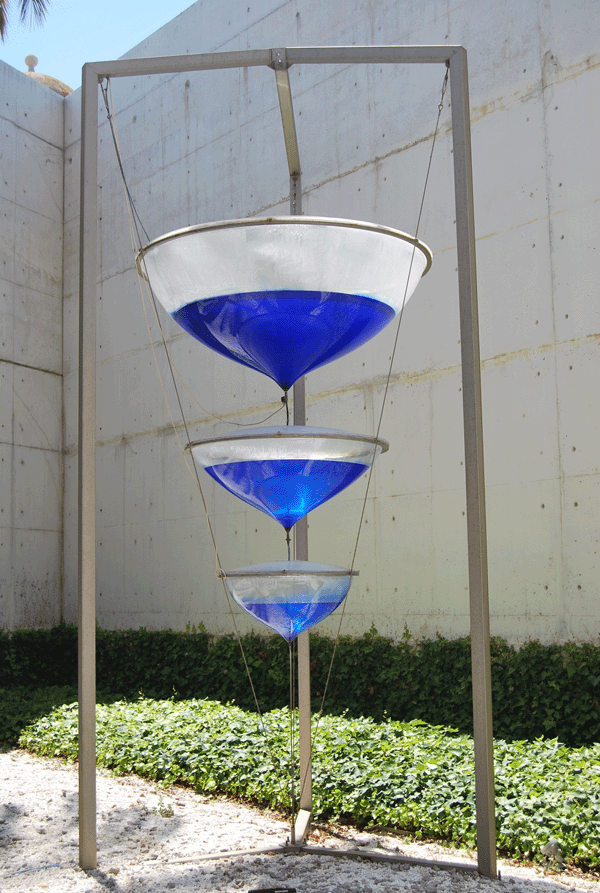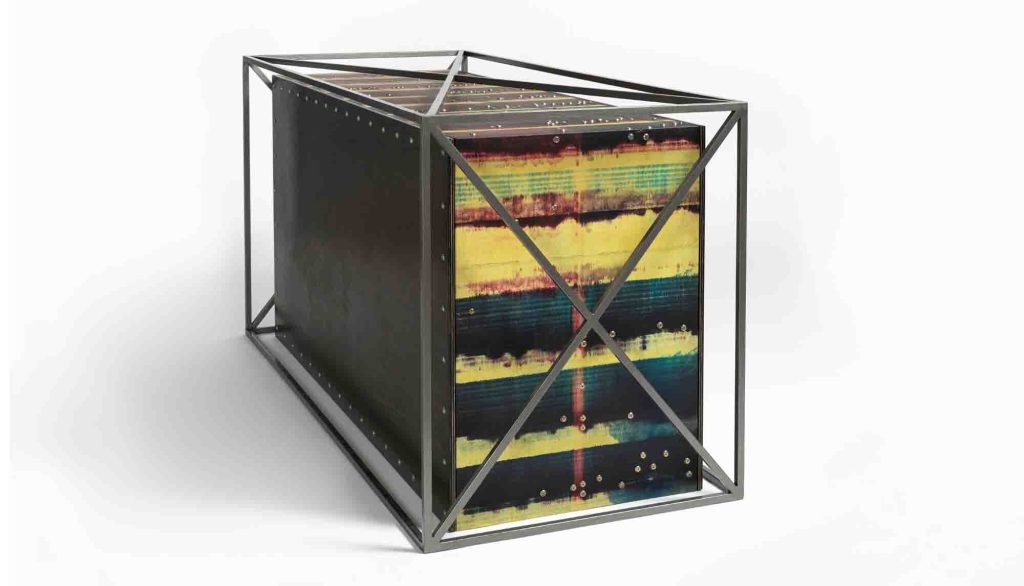
- Artist:
- Rebecca Horn
- Date:
- 1993
- Technique:
- Structure of stainless steel, three containers of Plexiglas, pumping system, distilled water and ink
- Dimensions:
- Structure: 477 x 223 x 224 cm Plexiglas: 193 Ø, 129,5 Ø, 88,5 Ø cm
- Origin:
- Es Baluard Museu d'Art Contemporani de Palma
- Registration number:
- 276
- Acquisition year:
- 2005
- Exposed:
- Yes
This iconic sculpture in the Es Baluard Collection has presided over the museum’s inner courtyard since it was inaugurated. Three Graces in Blue (1993) is an imposing exterior piece comprised of three large Plexiglas containers that are connected to each other, and arranged vertically by means of a stainless steel structure.
Horn plays with the sinuous shapes of these concave elements, present in her sculptural and installation production, and with the title of the work she activates shared readings and imaginaries in the spectator. The Greek myth of The Three Graces – representatives of beauty, love, sexuality and wisdom – converted practically into a genre in the history of classical art, is rescued by the German artist in a remake with an industrial appearance. The three bowls, connected by a pumping system that gives rise to an internal circuit with the water it contains, evoke three breasts or three curved lines associated to femininity which are interwoven with one another, as is customary in the depiction of the three sisters. In this way, the three become one, forming part of and sharing the water of the same process, one feeding the other, and this one the next, in an act of generosity and friendship, two values also implied by the myth of The Three Graces. The intense colour of the water is that of lapis lazuli, a powder that was used by classical painters to obtain the pigment known as ultramarine, utilised only in certain works because of its high cost.
The artist sets forth a double play in the same work, showing us a sculpture with a monumental appearance, thanks to the carcass that bestows the outer structure on it which holds up the containers, but the thing that actually activates the circuit and the water mechanism which lends meaning to the work is a simple drip. Because drips of water, their rhythms and presence, are another fundamental element of Horn’s installations and sculptures.
C.J.
She studied at the Hochschule für bildende Künste in Hamburg and Saint Martin’s College of Art in London. After living in New York from 1972 to 1981 she returned to Berlin, where she has been teaching.
As a result of a lung infection contracted in 1968, Horn was in convalescence for a long period of time during which she adapted her methods and works to her delicate state of health: she replaced sculptural materials with other, lighter ones, introduced elements such as ostrich feathers and fabric, turning them into extensions of parts of her body, as her first work Einhorn (Unicorn) demonstrates. She drew inspiration from solitude and fragility and incorporated her “body sculptures” into her performances, some of which were included in her cinematographic works, film being a medium she has worked with since 1970.
From 1980 on she progressively abandoned the body as the object and subject of her work in favour of mechanized sculptures, created using everyday objects such as spoons, typewriters, suitcases, metal hammers, musical instruments like the violin and the piano, all of them with a new poetical significance, charged with sensuality or even evoking a certain violence or anxiety. In this same decade she began to develop specific installations in places with an important historical and political past. Allusions to sex, desire, mysticism or literature and concepts such as the intuitive and the scientific, the corporeal nature and philosophy, have had a strong presence in her work from the start. As well as the introduction of music with Hayden Chisholm as collaborator, her last work expresses her quest to capture the latent energy of nature and people by making them visible through the effects of light, mirrors, painting machines, collage, drawing and poetry.
Horn has won awards on numerous occasions: the Documenta Preis, Kassel (1986), the Carnegie Prize, Carnegie International, Pittsburgh (1988), the Barnett and Annalee Newman Foundation Award, New York (2004), the Praemium Imperiale Prize for sculpture, Japan Art Association, Japan (2010), the Grande Médaille des Arts Plastiques of the Académie d’Architecture of Paris (2011). Her prolific career includes exhibitions at the Solomon R. Guggenheim Museum in New York (1993), the Neue Nationalgalerie in Berlin and the Tate Gallery in London (both in 1994), the church of the Convento de Santo Domingo of Pollença, Mallorca (2003), Es Baluard Museu d’Art Modern i Contemporani de Palma (2004), the Fundação Centro Cultural de Belém, Lisbon (2005), Martin-Gropius-Bau, Berlin (2006), and the Museum of Contemporary Art, Tokyo (2009). Her work forms part of the collections of outstanding museums such as the Solomon R. Guggenheim Museum in New York, the Irish Museum of Modern Art in Dublin, the Tate Collection in London, Los Angeles County Museum of Art and the Museu d’Art Contemporani de Barcelona.
E.B.
